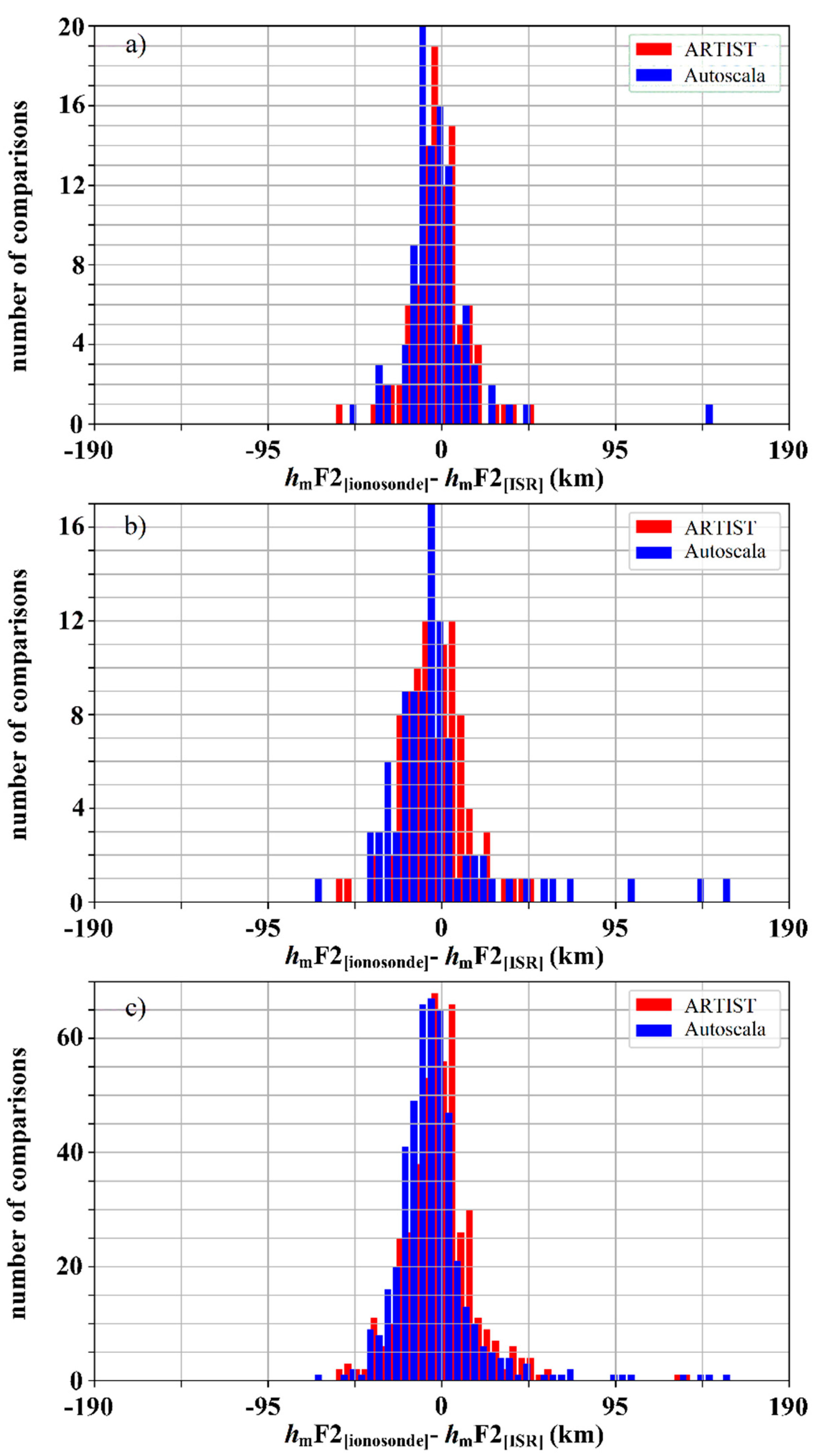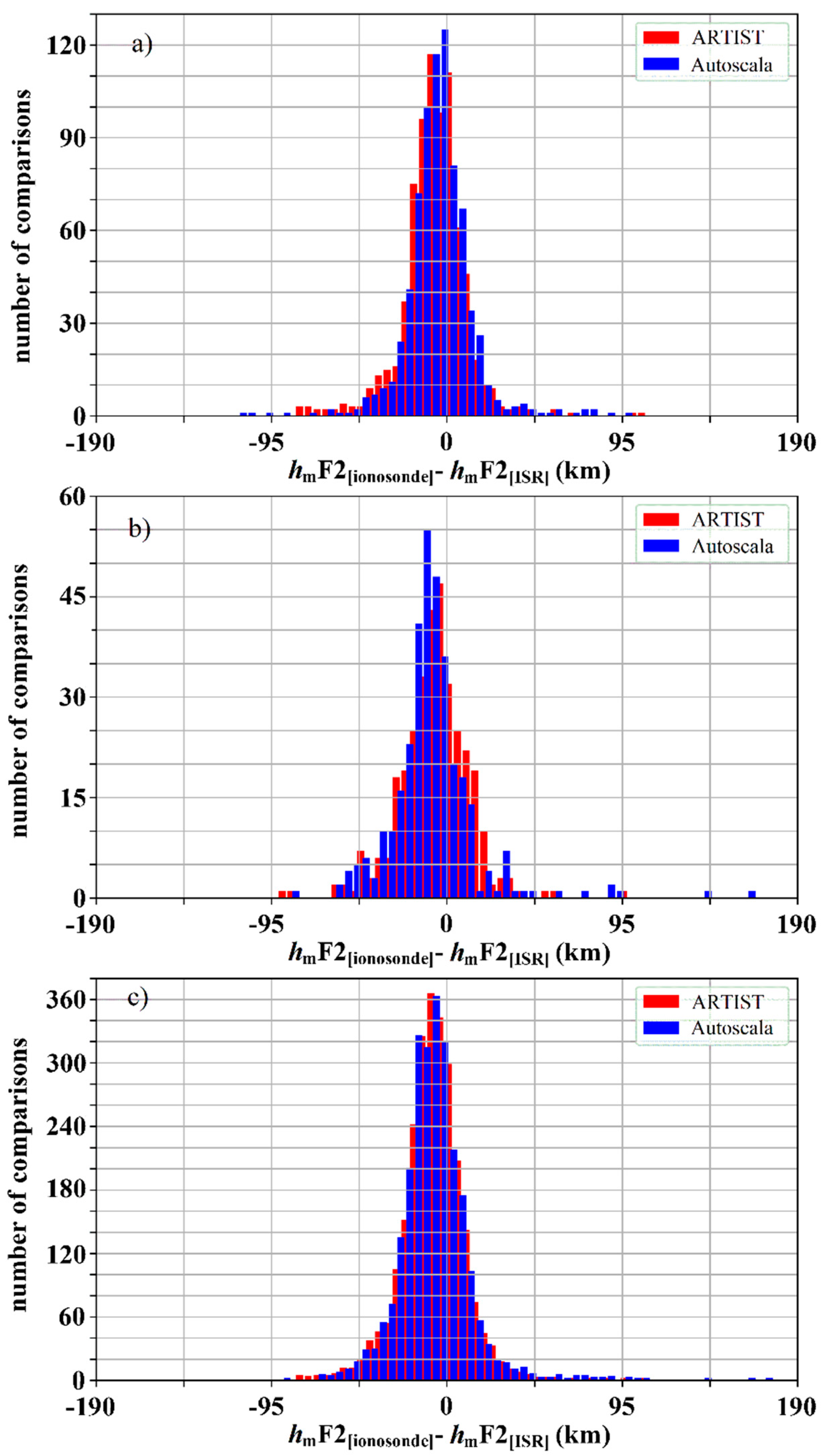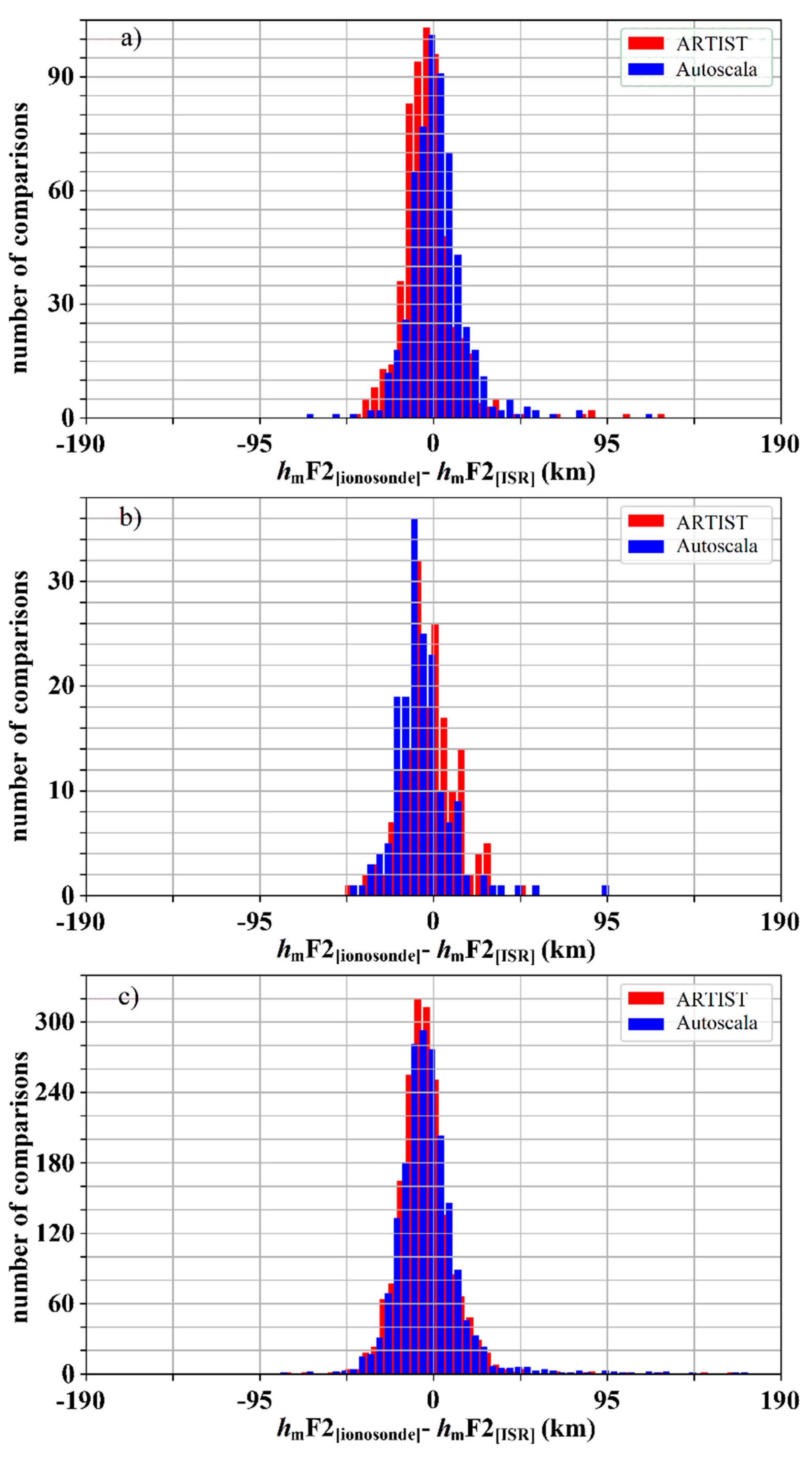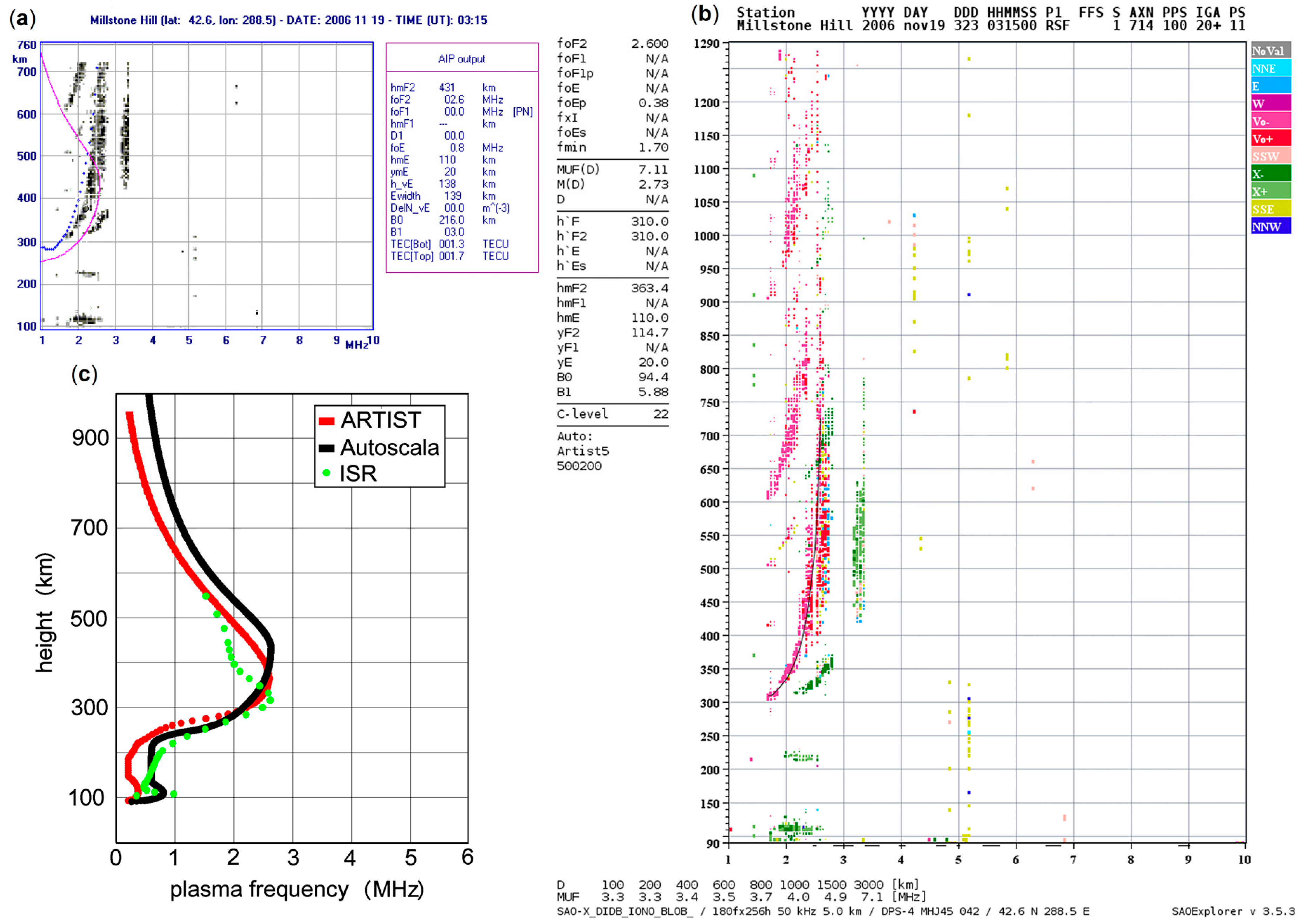The Accuracy of Real-Time hmF2 Estimation from Ionosondes
Abstract
1. Introduction
2. Materials and Methods
3. Results
4. Discussion and Conclusions
Author Contributions
Funding
Acknowledgments
Conflicts of Interest
References
- Shimazaki, T. Worldwide daily variability in the height of the maximum electron density of the ionospheric F2-layer. J. Radio Res. Lab. Jpn. 1955, 2, 85–97. [Google Scholar]
- McNamara, L.F. Accuracy of models of hmF2 used for long-term trend analyses. Radio Sci. 2008, 43, RS2002. [Google Scholar] [CrossRef]
- Elias, A.G.; Zossi, B.S.; Yiğit, E.; Saavedra, Z.; de Haro Barbas, B.F. Earth’s magnetic field effect on MUF calculation and consequences for hmF2 trend estimates. JASTP 2017, 163, 114–119. [Google Scholar] [CrossRef]
- Arikan, F.; Sezen, U.; Gulyaeva, T.L. Comparison of IRI-2016 F2 Layer Model Parameters with Ionosonde Measurements. J. Geophys. Res. Space Phys. 2019, 124, 8092–8109. [Google Scholar] [CrossRef]
- Fagre, M.; Zossi, B.S.; Chum, J.; Yigit, E.; Elias, A.G. Ionospheric high frequency wave propagation using different IRI hmF2 and foF2 models. J. Atmos. Sol.-Terr. Phy. 2019, 196, 105141. [Google Scholar] [CrossRef]
- Titheridge, J.E. Ionogram Analysis with the Generalised Program POLAN. UAG Report-93. 1985. Available online: http://www.ips.gov.au/IPSHosted/INAG/uag_93/uag_93.html (accessed on 1 May 2020).
- Reinisch, B.W.; Huang, X. Automatic calculation of electron density profiles from digital ionograms: 1. Automatic O and X trace identification for topside ionograms. Radio Sci. 1982, 17, 421–434. [Google Scholar] [CrossRef]
- Huang, X.; Reinisch, B.W. Automatic calculation of electron density profiles from digital ionograms: 2. True height inversion of topside ionograms with the profile-fitting method. Radio Sci. 1982, 17, 837–844. [Google Scholar] [CrossRef]
- Reinisch, B.W.; Huang, X. Automatic Calculation of electron density profiles from digital ionograms: 3. Processing of bottomside ionograms. Radio Sci. 1983, 18, 477–492. [Google Scholar] [CrossRef]
- Maruyama, T.; Ma, G.Y.; Tsugawa, T.; Supnithi, P.; Komolmis, T. Ionospheric peak height at the magnetic equator: Comparison between ionosonde measurements and IRI. Adv. Space Res. 2017, 60, 375–380. [Google Scholar] [CrossRef]
- Reinisch, B.W.; Galkin, I.A. Global Ionospheric Radio Observatory (GIRO). Earth Planets Space 2011, 63, 377–381. [Google Scholar] [CrossRef]
- Galkin, I.A.; Reinisch, B.W.; Huang, X.; Bilitza, D. Assimilation of GIRO data into a real-time IRI. Radio Sci. 2012, 47, RS0L07. [Google Scholar] [CrossRef]
- Hu, A.D.; Zhang, K.F. Using Bidirectional Long Short-Term Memory Method for the Height of F2 Peak Forecasting from Ionosonde Measurements in the Australian Region. Remote Sens. 2018, 10, 1658. [Google Scholar] [CrossRef]
- Kim, J.H.; Kim, Y.H.; Ssessanga, N.; Jeong, S.H.; Moon, S.I.; Kwak, Y.S.; Yun, J.Y. Regional ionosphere specification by assimilating ionosonde data into the SAMI2 model. Adv. Space Res. 2019, 64, 1343–1357. [Google Scholar] [CrossRef]
- Bibl, K.; Reinisch, B.W. The universal digital ionosonde. Radio Sci. 1978, 13, 519–530. [Google Scholar] [CrossRef]
- Reinisch, B.W.; Bibl, K.; Kitrosser, D.F.; Sales, G.S.; Tang, J.S.; Zhang, Z.M.; Bullett, T.W.; Ralls, J.A. The Digisonde 256 ionospheric sounder. In World Ionosphere/Thermosphere Study, WITS Handbook; Liu, C.H., Ed.; ICSU Science Committee on Solar-Terr. Phys.: Urbana, IL, USA, 1898; Volume 2, pp. 1–33. [Google Scholar]
- Mikhailov, A.V.; Belehaki, A.; Perrone, L.; Zolesi, B.; Tsagouri, I. Retrieval of thermospheric parameters from routine ionospheric observations: Assessment of method’s performance at mid-latitudes daytime hours. J. Space Weather Space Clim. 2012, 2, A03. [Google Scholar] [CrossRef]
- Elias, A.G. Filtering ionosphere parameters to detect trends linked to anthropogenic effect. Earth Planets Space 2014, 66, 113. [Google Scholar] [CrossRef]
- Bremer, J.; Damboldt, T.; Mielich, J.; Suessmann, P. Comparing long-term trends in the ionospheric F2-region with two different methods. J. Atmos. Sol.-Terr. Phy. 2012, 77, 174–185. [Google Scholar] [CrossRef]
- Scotto, C.; Pezzopane, M. A software for automatic scaling of foF2 and MUF (3000) F2 from ionograms. In Proceedings of the URSI XXVIIth General Assembly, Maastricht, Holland, 17–24 August 2002. [Google Scholar]
- Scotto, C. Electron density profile calculation technique for Autoscala ionogram analysis. Adv. Space Res. 2009, 44, 756–766. [Google Scholar] [CrossRef]
- Reinisch, B.W.; Haines, D.M.; Kuklinski, W.S. The new portable digisonde for vertical and oblique sounding. In Proceedings of the AGARD EPP 50th Symposium, London, England, 1–5 June 1992; Volume 11, pp. 1–11. [Google Scholar]
- Piggott, W.R.; Rawer, K. U.R.S.I. Handbook of Ionogram Interpretation and Reduction; US Department of Commerce National, Oceanic and Atmospheric Administration-Environmental Data Service: Asheville, NC, USA, 1972. [Google Scholar]
- Perrone, L.; Mikhailov, A.V.; Scotto, C.; Sabbagh, D. Testing of the Method Retrieving Consistent Set of Aeronomic Parameters With Millstone Hill ISR Noontime hmF2 Observations. IEEE Geosci. Remote Sens. Lett. 2020. [Google Scholar] [CrossRef]
- Mishra, P.; Singh, U.; Pandey, C.M.; Mishra, P.; Pandey, G. Application of student’s t-test, analysis of variance, and covariance. Ann. Card. Anaesth. 2019, 22, 407–411. [Google Scholar] [CrossRef]
- Chen, C.F.; Reinisch, B.W.; Scali, J.L.; Huang, X. The accuracy of ionogram-derived N (h) profiles. Adv. Space Res. 1994, 14, 43–46. [Google Scholar] [CrossRef]
- Penndorf, R. Classification of spread F ionograms. J. Atmos. Terr. Phys. 1962, 24, 771–778. [Google Scholar] [CrossRef]
- Shi, J.K.; Wang, G.J.; Reinisch, B.W.; Shang, S.P.; Wang, X.; Zherebotsov, G.; Potekhin, A. Relationship between strong range spread F and ionospheric scintillations observed in Hainan from 2003 to 2007. J. Geophys. Res. 2011, 116, A08306. [Google Scholar] [CrossRef]
- Reinisch, B.W.; Huang, X. Redefining the IRI F1 layer profile. Adv. Space Res. 2000, 25, 81–88. [Google Scholar] [CrossRef]





| High Magnetic Activity | |||||||
| Δ[Autoscala] (km) | Δ[ARTIST] (km) | RMSE[Autoscala] (km) | RMSE[ARTIST] (km) | N° of cases | p[Autoscala] | p[ARTIST] | |
| Night | −1.57 | 5.27 | 34.09 | 19.53 | 95 | 0.65622 | 0.00782 |
| Day | −1.32 | −3.02 | 21.65 | 16.41 | 100 | 0.54467 | 0.06524 |
| Night and day | −3.26 | −2.58 | 24.79 | 20.91 | 472 | 0.00418 | 0.00730 |
| Medium Magnetic Activity | |||||||
| Δ[Autoscala] (km) | Δ[ARTIST] (km) | RMSE[Autoscala] (km) | RMSE[ARTIST] (km) | N° of cases | p[Autoscala] | p[ARTIST] | |
| Night | −6.45 | −7.28 | 25.90 | 26.37 | 335 | 3.9·10−6 | 2.8·10−7 |
| Day | −3.00 | −8.7 | 19.71 | 20.79 | 768 | 2.3·10−5 | 6.0·10−34 |
| Night and day | −4.95 | −8.81 | 24.93 | 21.99 | 2611 | 1.3·10−24 | 3.1·10−101 |
| Low Magnetic Activity | |||||||
| Δ[Autoscala] (km) | Δ[ARTIST] (km) | RMSE[Autoscala] (km) | RMSE[ARTIST] (km) | N° of cases | p[Autoscala] | p[ARTIST] | |
| Night | −5.36 | −2.02 | 17.77 | 24.84 | 171 | 5.8·10−5 | 0.28876 |
| Day | 3.09 | −4.16 | 16.63 | 17.05 | 583 | 6.2·10−6 | 2.2·10−9 |
| Night and day | −1.85 | −5.81 | 20.07 | 18.32 | 1908 | 5.5·10−5 | 8.0·10−46 |
© 2020 by the authors. Licensee MDPI, Basel, Switzerland. This article is an open access article distributed under the terms and conditions of the Creative Commons Attribution (CC BY) license (http://creativecommons.org/licenses/by/4.0/).
Share and Cite
Scotto, C.; Sabbagh, D. The Accuracy of Real-Time hmF2 Estimation from Ionosondes. Remote Sens. 2020, 12, 2671. https://doi.org/10.3390/rs12172671
Scotto C, Sabbagh D. The Accuracy of Real-Time hmF2 Estimation from Ionosondes. Remote Sensing. 2020; 12(17):2671. https://doi.org/10.3390/rs12172671
Chicago/Turabian StyleScotto, Carlo, and Dario Sabbagh. 2020. "The Accuracy of Real-Time hmF2 Estimation from Ionosondes" Remote Sensing 12, no. 17: 2671. https://doi.org/10.3390/rs12172671
APA StyleScotto, C., & Sabbagh, D. (2020). The Accuracy of Real-Time hmF2 Estimation from Ionosondes. Remote Sensing, 12(17), 2671. https://doi.org/10.3390/rs12172671






